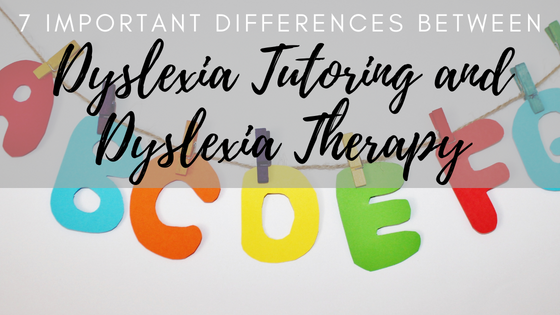
7 Important Differences Between Dyslexia Tutoring and Dyslexia Therapy
Once your student has a dyslexia diagnosis, seeking the right kind of help can be overwhelming. There are so many different tutors, teachers, therapists, styles, and services. It is important to know the differences between the kinds of treatments that are available. Read on to learn 7 important differences between dyslexia tutoring and dyslexia therapy:
- Different end goals: Dyslexia tutoring is the option that is most commonly offered to students. Tutoring can employ many different approaches, from prescriptive computer programs to one-on-one teaching sessions. Mostly, dyslexia tutoring work focuses on improving the student’s specific areas of deficit. In contrast, dyslexia therapy is designed to create an overall cognitive change in the student’s learning progress. Rather than just aiming at specific academic deficits, therapy takes a more holistic approach. Therapy sessions aim to remediate underlying language processing skills.
- Different Frequency: In general, dyslexia tutoring is offered at a lower weekly frequency, like once per week. On the other hand, dyslexia therapy, such as at Dyslexia on Demand, usually is scheduled four times per week. Frequency is important for improvement in students. These sessions can happen in one-on-one or group sessions with Certified Academic Language Therapists (CALTs).
- Administered by different professionals: Tutoring can be done by certified classroom teachers or special education generalists. Dyslexia therapy, however, can only be implemented by a Certified Academic Language Therapist. CALTs provide diagnostic, explicit, systematic, multisensory structured language intervention. This approach focuses on accuracy, knowledge, and independence for students.
- Need-based v. Comprehensive: Tutoring for dyslexic students is usually based on academic need. It tends to be a great way for students to review and address issues with concepts they’ve already learned. While tutoring can be helpful for specific aspects of reading or spelling, it is not a wholly comprehensive solution. Dyslexia therapy is a more comprehensive approach to helping students. Orton-Gillingham, a proven technique is used and then built upon in therapy.
- Layers and Complexity: While tutoring can be beneficial, it doesn’t tend to have the layers or complexity that is required by the dyslexic brain. Tutoring often addresses issues on the surface level without going deeper into the brain’s needs. Tutoring, then can be a bit prescriptive. Instead, dyslexia therapy implements a number of programs that focus on rewiring parts of students’ brains in order to create new neuropathways. This sets students on the road to becoming proficient readers.
- Facing the future: Dyslexia therapy programs like those offered at Dyslexia on Demand are based on a multi-year curriculum that is built on the success of Alphabetic Phonics, the Dyslexia Training Program, and the Texas Scottish Rite Hospital for Children Literacy Program. Like dyslexia tutoring, therapy aims to help students achieve and maintain better word recognition, fluency, and comprehension. Therapy notably also puts a focus on helping students with the transition from a therapy setting to a real world setting.
- Online can be an advantage: Dyslexia tutoring can take place in person or via online sessions. Online, tutors or therapists are able to see student’s faces as they work with the information that they’re reading. This way, there’s a unique perspective of how a student is working to process information. Dyslexia on Demand works exclusively online, matching CALTs with students for their therapy sessions.
Knowledge is power. Knowing what your dyslexic student needs in order to succeed will help you to choose the intervention strategy that is just the right fit. Reach out to the experts at Dyslexia on Demand, or call: 888-292-3906.







